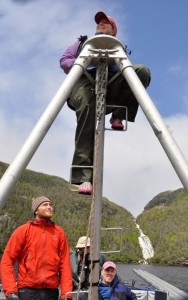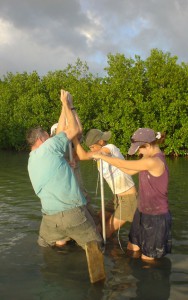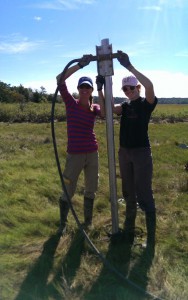Coring
Sedimentary analysis requires sedimentary samples. While we often collect small surface samples that provide modern corollaries to the paleo-record, researching the paleo environment requires the collection of sediment cores.
A sediment core is a type of sample that captures the stratigraphic layers with depth while preserving the depositional sequence (younger sediments are at the top and older sediments are at the bottom).
There are different tools and techniques and types of cores. Which technique used and what type of core collected depends on the nature of the environment and the research questions being asked.
Gouge Coring

Gouge coring is primarily done as a minimally invasive form of prospection. The gouge core implement consists of a meter long sharpened and rounded metal channel (like half of a small diameter pipe) that attaches to rods and a handle. By pushing the gouge into the sediment until we hit the point of refusal (where we can’t push any further) we can identify the depth of the sediment at a specific spot. The channel at the base of the gouge allows for the collection of a small amount of material from the sample spot. It’s rarely enough material to perform laboratory analysis but it does tell us exactly what the sediment sequence and how thick those layers are at a site. The gouge is best used in marshes and other terrestrial sites.
Russian Peat Coring

A Russian Peat corer is an ultra portable coring system designed for the collection of organic rich marsh sediments without compacting those sediments.
For projects dealing with sea level reconstructions, the depth in a core of specific plants, micro-fossils, or sediment types must be known to a high degree of accuracy. The Russian Peat corer preserves those depths by avoiding compaction. Akin to an elongated and sharpened melon-baller, the Russian Corer is pushed down into the marsh a specific depth, and then rotated to scoop uncompacted sediments into the sample collection chamber. By carefully measuring the depth into the sediment that the Russian was pushed, we can identify the elevation of the samples collected. Similar to the gouge, the Russian consists of a short sample collection chamber attached to rods and a handle.
Due to the short length of the Russian sample chamber (50cm), in order to capture the complete sedimentary sequence numerous samples often have to be collected. Depending on the expected nature of the lab work, multiple samples at the same depth are often collected since the Russian corer does not collect much sediment.
Percussion Coring/Push Coring
Capable of being performed in numerous environments, percussion and push coring techniques are just as they sound. Push coring is simply pushing the core barrel (in our case an aluminum or polycarbonate tube of 2”, 3”, 3.75” or 4” diameters) into the sediment by hand. Percussion coring varies in that the core is driven into the sediment by a percussion instrument such as a mallet or slide hammer.
A push core is useful in that it causes very little disturbance to the more delicate upper layers of a sub-aqueous sediment. Both push coring and percussion coring require very little equipment, but penetrative depth can be quite limited and the risk of compaction quite high.
Vibracoring

The principle coring technique employed by the Coastal Resarch Lab, vibracoring uses a vibrating motor to assist in driving the core barrel deeper into the sediment.
The vibrating motor attaches to the top of the core barrel by means of a waterproof flexible shaft. Since the motor is stationary during the coring operation and it’s the shaft that travels with the core, vibracores can be collected in both terrestrial or sub-aqueous settings.
The vibrations, traveling to the core by means of the shaft, do not drive the core barrel into the sediment. The vibrations in the core barrel cause liquefaction of the surrounding sediments to occur. The liquefied sediments are easier to push the core barrel through.
The limiting factors to this form of vibracoring are shaft length (the longer the flexible shaft the more vibrational energy is lost between the motor and the core barrel), tube length (the vibrations are attenuated over the length of the barrel meaning that at the bottom of a longer core the effects of liquefaction are dampened), and water depth (in addition to requiring longer shafts for greater depths, pushing a core by hand becomes much harder with increasing depths as numerous rods need to be used which can become unmanageable).
Vibracoring requires a great deal of equipment, and despite its limitations we have successfully recovered cores 8m (26 ft) in length from water depths exceeding 10m (32 ft).
A drawback to vibracoring is that the risk of compaction is quite high and the vibrations can significantly disturb the fragile sediment/water interface at the top of the core. Due to the likelihood of this disturbance, a push core in almost always collected alongside the vibracore in marine or lacustrine settings.
